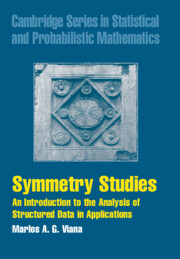Book contents
- Frontmatter
- Contents
- Preface
- 1 Symmetry, Classification, and the Analysis of Structured Data
- 2 Sorting the Labels: Group Actions and Orbits
- 3 Connecting Symmetries and Data: Linear Representations
- 4 Data Reduction and Inference: The Canonical Projections and Their Invariants
- 5 Examples and Techniques
- 6 Symmetry Studies of Short Symbolic Sequences
- 7 Symmetry Studies of Curvature Data
- 8 Symmetry Studies of Planar Chirality
- Appendix A Computing Algorithms
- Appendix B Glossary of Selected Symbols, Notations, and Terms
- Bibliography
- Index
2 - Sorting the Labels: Group Actions and Orbits
Published online by Cambridge University Press: 06 July 2010
- Frontmatter
- Contents
- Preface
- 1 Symmetry, Classification, and the Analysis of Structured Data
- 2 Sorting the Labels: Group Actions and Orbits
- 3 Connecting Symmetries and Data: Linear Representations
- 4 Data Reduction and Inference: The Canonical Projections and Their Invariants
- 5 Examples and Techniques
- 6 Symmetry Studies of Short Symbolic Sequences
- 7 Symmetry Studies of Curvature Data
- 8 Symmetry Studies of Planar Chirality
- Appendix A Computing Algorithms
- Appendix B Glossary of Selected Symbols, Notations, and Terms
- Bibliography
- Index
Summary
Introduction
The analysis of variance shown in Table (1.13) on page 9 of Chapter 1 was a consequence of the joint action of G = {1, h, ν, o} and S5 shuffling, respectively, the rows and columns of Table (1.12). The study and data-analytic applications of these rules for shuffling the experimental labels, called group actions, are among the main objectives of the present chapter. The study of group actions and orbits is an integral part of any symmetry study, and was identified earlier in the summary of Chapter 1, on page 23, steps 3, and 4. The algebraic aspects in this and the next two chapters follow closely from Serre (1977, Part I).
Permutations
In the classification of the binary sequences in length of 4 introduced in Chapter 1, the symmetries of interest were the permutations of the four positions and the permutations of the two symbols {u, y}. These sets of permutations, together with the operation of composition of functions, share all the defining algebraic properties identified in the multiplication table of {1, ν, h, o}, characteristics of a finite group. In Section 1.7 of Chapter 1, it was shown that permutations appear in many, if not all, steps of a symmetry study. They appear as labels for the voting preference data on page 12, in matrix form as linear representations, on page 6, and as shuffling machanisms with which sets of labels could be classified and interpreted for the purpose of describing the data indexed by those labels.
- Type
- Chapter
- Information
- Symmetry StudiesAn Introduction to the Analysis of Structured Data in Applications, pp. 30 - 62Publisher: Cambridge University PressPrint publication year: 2008

